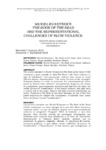| dc.contributor.author | Simal, Begoña | |
| dc.date.accessioned | 2023-03-22T11:13:12Z | |
| dc.date.available | 2023-03-22T11:13:12Z | |
| dc.date.issued | 2022 | |
| dc.identifier.citation | Simal González, Begoña. Muriel Rukeyser's The Book of the Dead and the Representational Challenges of Slow Violence. Revista de Estudios Norteamericanos, vol. 26, 2022, pp. 107-29 | es_ES |
| dc.identifier.issn | 2253-8410e | |
| dc.identifier.issn | 1133-309X | |
| dc.identifier.uri | http://hdl.handle.net/2183/32738 | |
| dc.description.abstract | [Resumen] Los sucesos narrados por Muriel Rukeyseren The Book of the Dead (1938) constituyen un buen ejemplo de lo que Rob Nixon denomina “violencia lenta,” un tipo de violencia alejada de la espectacularidad, violencia de progresivo “desgaste” difícil de trasladar a una obra literaria. Este artículo estudia las estrategias desplegadas por Rukeyser para superar esos obstáculos a la hora de representar literariamente la “violencia lenta”: optando, primero,por un patchwork de géneros, eligiendo, además, la estructura del poema-secuencia polifónico y, por último, dando visibilidad al proceso de “wastification” o “basurización” de los mineros que protagonizan el poema. Leído desde la óptica de las recientes corrientes críticas conocidas como Waste Studies y Waste Theory, The Book of the Dead se erige como una de las primeras obras poéticas en examinar de forma conjunta la materialidad de los desechos tóxicos(el polvo de sílice) y la “basurización” humana. | es_ES |
| dc.description.abstract | [Abstract] The events narrated in Muriel Rukeyser’s The Book of the Dead(1938) constitute a good example of what Rob Nixon calls“slow violence,” a type of “attritional,” non-spectacular violence that seems to resist effective literary representation. This essay focuses on the strategies Rukeyser deploys in order to overcome the representational limits posed by Nixon’s“slow violence”: the patchwork of genres, the choice of a polyphonic poem-sequence structure and, last but not least, the visible process of “wastification” of the tunnel workers, who play such a central role in the poem. Read in the light of recent scholarship on waste, Rukeyser’s The Book of the Dead emerges as one of the first poem sequences to explorethe conjunction of material toxic waste (silica dust) and human “wastification | es_ES |
| dc.description.sponsorship | Ministerio de Ciencia e Innovación ; PID2019-106798G B-I00/AEI/10.13039/501100011033) | es_ES |
| dc.language.iso | eng | es_ES |
| dc.publisher | Universidad de Sevilla. Facultad de Filología | es_ES |
| dc.relation.uri | http://dx.doi.org/10.12795/REN.2022.i26.07 | es_ES |
| dc.rights | Atribución-NoComercial-CompartirIgual 4.0 Internacional | es_ES |
| dc.rights.uri | http://creativecommons.org/licenses/by-nc-sa/3.0/es/ | * |
| dc.subject | Muriel Rukeyser | es_ES |
| dc.subject | The Book of the Dead | es_ES |
| dc.subject | Slow violence | es_ES |
| dc.subject | Waste Theory | es_ES |
| dc.subject | Waste Studies | es_ES |
| dc.subject | Rubbish Theory | es_ES |
| dc.subject | Violencia lenta | es_ES |
| dc.title | Muriel Rukeyser's The Book of the Dead and the Representational Challenges of Slow Violence | es_ES |
| dc.type | info:eu-repo/semantics/article | es_ES |
| dc.rights.access | info:eu-repo/semantics/openAccess | es_ES |
| UDC.journalTitle | Revista de Estudios Norteamericanos | es_ES |
| UDC.volume | 26 | es_ES |
| UDC.startPage | 107 | es_ES |
| UDC.endPage | 129 | es_ES |






